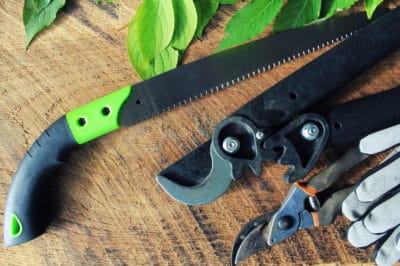Growing Pomegranates
Native to what is now Iran, pomegranates have adapted to hot, arid climates. They typically perform best in USDA Zones 8 to 10, but some are hardy in Zone or even 6. You can plant them in any kind of soil as long as it drains well. Water weekly – or more often in hot, windy weather – but never let water stand on the roots. Fertilize two or three times a year while actively growing.
Tools for Pruning
The proper tools make pruning easier and decrease the risk of injury to both you and the plant. Sharpen cutting tools before use; clean and oil them after use. Here are the basics:
- Short-handled bypass pruning shears
- Long-handled bypass loppers
- Small chainsaw (use eye protection)
- Pruning sealant
- Putty knife
- Leather gloves.
Pruning for Fruit
If your goal is plenty of fruit, use the commercial grower’s techniques. After removing any dead or crossed branches, cut the branches back to spur new fruit-producing spurs. Make a slanting cut just above a growth node. When dealing with a mature tree that isn’t producing much fruit, pruning hard can help invigorate the tree and increase both flowering and fruit set.
Pruning to Shape
If you care less about fruit and more about the pomegranate’s ornamental value, you’ll want to prune to showcase the naturally arching form. Again, remove dead, crossed branches first. Prune for a tree shape by choosing one main stem when the tree is young and prune to force growth into that stem. Prune the branches lightly to increase bushiness.
When to Prune
Like most deciduous fruit trees, the pomegranate goes dormant in winter. This is the best time for major pruning. Ideally, you should prune just as the leaf buds start to develop. You can prune broken or diseased branches any time, however. Pomegranates also produce suckers and these can be pruned at any time of the year.
Other Pruning Tips and Tricks
Pay close attention to growth nodes when pruning for shape or fruit production. When pruning suckers or to completely remove a branch, however, prune back to the base. If a branch is diseased, always clean your tools before moving on to another branch or tree. Use pruning sealant on any branches that are ½ inch or more in diameter to protect from insects and disease organisms.
